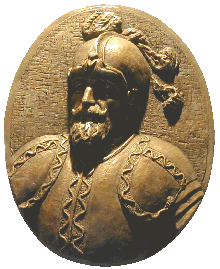This article may require copy editing for standard English usage. (February 2024) |
Alonso de Alvarado Montaya González de Cevallos y Miranda (1500–1556) was a Spanish conquistador and knight of the Order of Santiago.
Alonso de Alvarado | |
|---|---|
 Alonso de Alvarado | |
| Born | 1500 |
| Died | 1556 |
| Nationality | Spanish |
| Occupation | Conquistador |
Born in Secadura de Trasmiera, Spain,[1]: 398 Alvarado served under Hernán Cortés in Mexico before joining Francisco Pizarro's campaign in Peru.
In 1534, he arrived in Peru with his uncle Pedro de Alvarado, seeking riches. He participated in several key battles during the conquest and subsequent civil wars (1537–1555), including the defense of Lima against Manco Inca Yupanqui's siege (1536), the Battle of Las Salinas (1538), and later conflicts at Chupas and Jaquijahuana.
While some contemporaries accused him of greed and brutality, Alvarado remained a loyal supporter of the Spanish crown throughout the Peruvian civil wars. He consistently sided with those he believed represented the crown's authority, even when such alliances proved risky or unprofitable.[2]
For instance, in 1537, he commanded Pizarro's forces against Diego de Almagro's claim on Cuzco. Although defeated and captured at the Battle of Abancay,[3]: 257 he escaped and rejoined Pizarro. He participated in subsequent conflicts as a prominent military leader, though not always achieving personal victories. Nonetheless, he held a high military position and was considered a pillar of the Spanish cause.[2]
Alvarado married during a brief visit to Spain in 1544.[2]
In 1553, when Francisco Hernández Girón rebelled, Alvarado led the royalist forces. However, he suffered a decisive defeat at the Battle of Chuquinga (1554). Dejected by this final setback, he fell ill and died.
His most significant achievement was the pacification of Chachapoyas in northeastern Peru (1535–1536). This conquest marked the first Spanish foray into the Amazon Basin from Peru.[2]
Search for El Dorado edit
Alonso de Alvarado was a forerunner of the expeditions that penetrated the Amazon Basin. In 1535, he departed from Trujillo, Peru, crossed the Andes, and reached the land of the Chachapoyas. A few years later, the city that is now the capital of the Amazonas department was founded in this region.
The chronicler Pedro Cieza de León mentions the first founding of Chachapoyas:
On the fifth of September in the year of the Lord one thousand five hundred and thirty eight Ihsu Christo, with sixty Spaniards under the control of captain Alonso de Alvarado arrived in [...] "Xalca" and made the first foundation of Chachapoyas.
Captain Luis Valera, father of the Cachapoya Jesuit Blas Valera, was also present at the founding. The Inca Garcilaso de la Vega drew on Blas Valera's chronicles for his descriptions of the Tawantinsuyu in his "Royal Commentaries of the Incas."
While in Chachapoyas, Alvarado learned of the legendary city said to hold fabulous treasures deep within the rainforest, El Dorado. He organized further expeditions along the Marañón River, founding the city of Moyobamba in 1540.
Civil Wars in Peru edit
Alvarado participated in the Peruvian civil wars between Diego de Almagro and Francisco Pizarro.[4] Captured by Almagro in 1537, he escaped and joined Pizarro's forces. Siding with the crown, Alvarado helped defeat Almagro's followers at the Battle of Las Salinas in 1538.[3]: 260, 264
Following Francisco Pizarro's orders, Alvarado sought an ideal location for a city halfway between Lima and Cusco in 1539. He co-founded Huamanga with Francisco de Cárdenas.
In 1541, Diego de Almagro II ("El Mozo") assassinated Francisco Pizarro, seeking revenge for his father's death. The following year, Governor Cristóbal Vaca de Castro, allied with Alvarado, defeated El Mozo at the Battle of Chupas. Alvarado's loyalty and merits earned him recognition from King Charles I of Spain. He was knighted in the Order of Santiago, appointed Marshal of Peru, and married upon his return to Spain.[1]: 398
Alvarado returned to Peru in 1546. In April 1548, he reaffirmed his loyalty to the crown by fighting against Gonzalo Pizarro, Francisco Pizarro's rebellious brother. Under Pedro de la Gasca's command, he secured victory at the Battle of Jaquijahuana. However, this victory did little to quell discontent among Spanish settlers opposed to the growing authority of the Spanish court's representatives. In 1553, as captain-general and chief justice in La Plata and Potosí, he quelled a rebellion led by Sebastian de Castilla. Defeated by Francisco Hernández Girón's rebel forces in the Battle of Chuquinga in 1554, Alvarado died in Lima in 1556.[1]: 398
Chachapoyas, founded by the Spanish, served as a port city for numerous expeditions venturing into the rainforest. The legend of El Dorado, a city of gold, fueled the early explorers' thirst for wealth. Though obsessed with finding this mythical treasure, their expeditions faced unforeseen hardships – famine, disease, hostile indigenous people, and the treacherous rainforest itself.
The El Dorado envisioned by the conquistadors was a city with streets and temples paved with gold, embellished with massive golden structures and plazas. Its location was variously thought to be north of Chachapoyas, near Quillabamba, or even deeper in the central rainforest and Colombia. While the legend itself proved to be a myth, it nonetheless opened doors for the initial colonization and evangelization of vast, remote regions of South America.
References edit
- ^ a b c Leon, P., 1998, The Discovery and Conquest of Peru, Chronicles of the New World Encounter, edited and translated by Cook and Cook, Durham: Duke University Press, ISBN 9780822321460
- ^ a b c d One or more of the preceding sentences incorporates text from a publication now in the public domain: Bandelier, Adolph Francis Alphonse (1907). "Alonzo de Alvarado". In Herbermann, Charles (ed.). Catholic Encyclopedia. Vol. 1. New York: Robert Appleton Company.
- ^ a b Prescott, W.H., 2011, The History of the Conquest of Peru, Digireads.com Publishing, ISBN 9781420941142
- ^ Andagoya, Pascual de. Narrative of the Proceedings of Pedrarias Davila. The Hakluyt Society. p. 54. Retrieved 21 June 2019 – via Wikisource.
Sources edit
- Taken from es.wikipedia.org Alonso de Alvarado